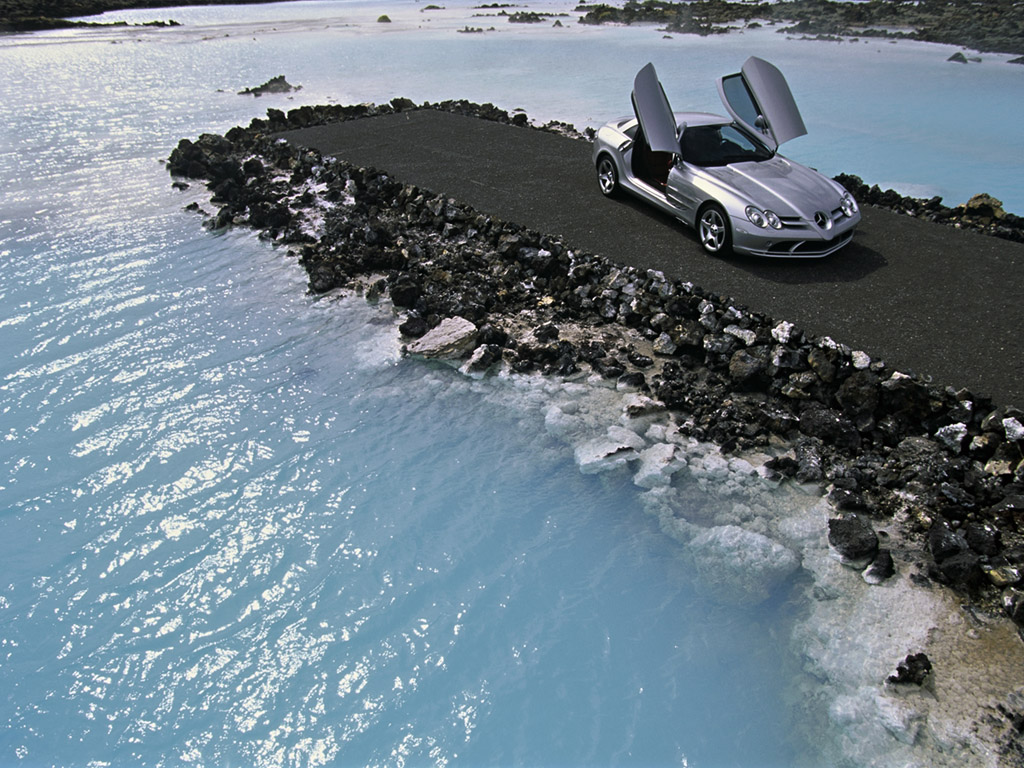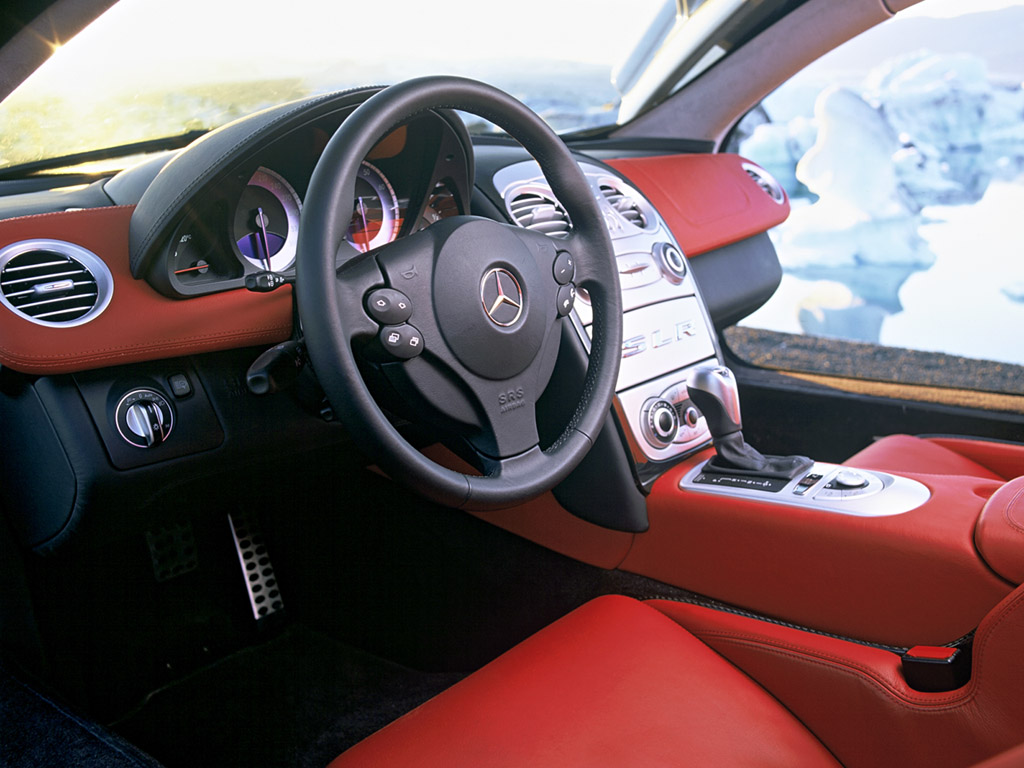Mercedes Benz SLR McLaren
(from Mercedes-Benz Press
Release) The new Mercedes-Benz SLR McLaren is an impressive
testament to the competence and experience of Mercedes-Benz and our
Formula 1 partner McLaren in the development and production of
high-performance sports cars. The two-seater, with its striking
swing-wing doors and styling elements borrowed from the Formula 1 Silver
Arrows, builds on the legacy of the famous SLR race cars of the 1950s.
Equipped with cutting-edge race car technology and ground-breaking new
Mercedes developments, designed to ensure a high standard of safety and
suitability for day-to-day use, the new SLR creates a distinctive image
for itself as a 21st-century Gran Turismo – a thrilling synthesis of
tradition and innovation.
The newly developed V8 supercharged engine delivers an output of 460
kW/626 hp and accelerates the sports car from 0 to 100 km/h in 3.8
seconds. The top speed is approximately 334 km/h. The body of the new
SLR, like those of the Mercedes-McLaren Formula 1 race cars, is made
from carbon fibre composites – lightweight materials which demonstrate
exemplary energy absorption, hence ensuring the highest standard of
occupant protection. The SLR is the world's first series-produced car to
have a front crash structure manufactured entirely from carbon fibres.
Adaptive airbags, newly developed kneebags and sidebags, belt tensioners,
high-performance ceramic brake discs and an automatically adaptive
airbrake in the boot lid round off the range of safety equipment on
board the Mercedes-Benz SLR McLaren, setting new standards in this
vehicle class.
Technology way ahead of its time and an abundance of power – these were
the hall-marks of the legendary SLR race cars in which Fangio, Moss,
Kling and other Mercedes drivers achieved spectacular victories in all
of the major road races in 1955. The new SLR demonstrates the same
characteristics, its groundbreaking technical innovations distinguishing
it as the Mercedes-Benz among high-performance sports cars.
Two Longitudinal
Members made from Carbon Fibre Composite
Absorb Energy in a Head-On Collision
The 21st-century Gran
Turismo is made almost entirely from carbon fibre composite. This
lightweight yet extremely rigid material originated in the aeronautical
and space industries and has also proven its benefits in today's Formula
1 race cars. The weight advantage of the high-tech material over steel
is around 50 percent, and the carbon fibres, on impact, are
characterised by four to five times higher energy absorption than steel
or aluminium. Mercedes-Benz exploits these qualities by incorporating
two 620-millimetre longitudinal members made from carbon fibre in the
front structure of the new SLR. These absorb the entire energy of the
crash in a defined head-on collision, leaving the passenger cell largely
undamaged. It is also made entirely from carbon fibre composite and
therefore offers a very safe survival zone in side-on or rear-end
collisions too.
Mercedes-Benz has introduced new material technology to the manufacture
of the brake discs too. They are made from fibre-reinforced ceramic and
are characterised by high fade-resistance and a very long life. In
collaboration with the electrohydraulic braking system, Sensotronic
Brake Control (SMC™), they allow outstanding deceleration figures too,
impressively underlining the motor racing heritage of the Mercedes-Benz
SLR McLaren.
460-kW/626-hp V8 powerplant with Cutting-Edge Compressor Technology
In the interests of optimum
dynamic handling and high stability on braking, the new Mercedes-Benz
SLR McLaren has a front mid-engined design. The high-performance V8
engine, mounted on a robust aluminium frame, is installed at a low level
which allows a low centre of gravity for agile handling.
With its 5.5-litre displacement, the supercharged engine develops a peak
output of 460 kW/626 hp and delivers its maximum torque of 780
Newtonmetres from 3250 rpm – a figure which remains constant across a
broad engine speed range of up to 5000 rpm. This means that the SLR
8-cylinder is among the most powerful engines currently available in a
series-produced roadgoing sports car. This high-performance car takes
just 3.8 seconds to sprint from 0 to 100 km/h, it passes the 200 km/h
mark after 10.6 seconds, and from a standing start it takes just 28.8
seconds to reach 300 km/h. The top speed is 334 km/h.
Water-type charge-air cooling, dry sump lubrication and four metal
catalytic converters are further special features of this powerful
engine – an engine which already meets stringent EU 4 exhaust gas
regulations which are not due to come into force until 2005.
The 5-speed automatic transmission, fitted as standard, is also designed
for high performance. It allows the driver to choose between three
programs with different shift characteristics. When "Manual" is
selected, the five gears can either be shifted using buttons on the
steering wheel or using the selector lever's Touchshift function. In
this mode the driver can also select between three shift stages –
"Sport", "SuperSport" and "Race" – significantly shortening the shift
times still further for an even sportier drive.
Aerodynamic Concept uses Expertise from the World of Formula 1
The body design of the Gran Turismo with
the Mercedes star takes classical styling elements from the legendary
SLR race cars of the 1950s and blends them masterfully with the
sophisticated, avantgarde design language of both the latest Mercedes
passenger car models and of the modern-day Silver Arrow race cars which
took the McLaren Mercedes team to Formula 1 World Championship glory in
1998 and 1999. The design's concept, in other words, thrillingly spans
the divide between past and present, whilst at the same time showing the
way forward for the sports car designs of tomorrow.
In order to meet the highest of standards in terms of handling at top
speed, directional stability and the cooling air requirements necessary
for high-performance cars of this kind, Mercedes-Benz worked with
McLaren on developing this model's superlative aerodynamics, ensuring
exemplary roadholding plus the on-road safety standards typical of
Mercedes. Following extensive wind-tunnel tests, the Mercedes-Benz SLR
McLaren was given a virtually smooth underbody with a special
six-channel diffusor under the rear. Both features are familiar design
principles from Formula 1. They ensure that the airflow beneath the
vehicle is virtually unimpeded and that negative lift, or downforce, is
produced at higher speeds. The distinctive sidepipes on each side of the
vehicle are also the result of this high-performance sports car's
aerodynamic underbody concept: a conventional exhaust gas system would
have disrupted the smooth line of the underbody.
At the rear of the SLR an adaptive spoiler provides additional downforce.
From a speed of 95 km/h, it automatically adopts a 10-degree position,
increasing the contact pressure at the rear axle. The spoiler also
doubles as an airbrake: when the driver brakes heavily, it rises to an
angle of 65 degrees, not only ensuring increased aerodynamic drag but
also shifting the aerodynamic centre further towards the rear. This
lends the SLR excellent stability when braking from high speeds.
Functionality and Luxury Stylishly Combined



